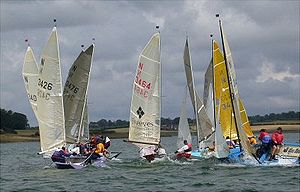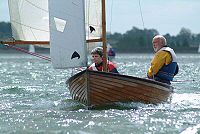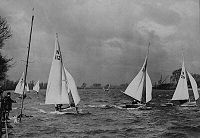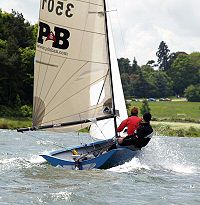.gif)
National 12 (dinghy)
Encyclopedia
The National 12 is a two-person, two-sail, twelve-foot (3.6 metre) long sailing dinghy. They are sailed extensively in the UK. The National 12 is a development class with a long, famous and intriguing history. The class was started in 1936 by the Royal Yachting Association
as an alternative to the more expensive International 14s. The rules limit the length of the boat to 12 ft, beam to 6 ft 6 in, an all up weight to 78 kg and a sail area of 10.4 m2. National 12s are sailed on all types of water from narrow rivers to the open sea. The class holds a national championships on an annual basis – known as Burton Week after the premier prize of the week: The Sir William Burton Cup – at various venues around the UK coast.
The rules limit the length of the boat to 12 ft, beam to 6 ft 6 in, an all up weight to 78 kg and a sail area of 10.4 m2. National 12s are sailed on all types of water from narrow rivers to the open sea. The class holds a national championships on an annual basis – known as Burton Week after the premier prize of the week: The Sir William Burton Cup – at various venues around the UK coast.
The National 12 is a development class where within a set of rules (and with occasional considered changes to those rules) the boats have been able to evolve over time, moving from wood and clinker
construction to high-performance glass and carbon fibre-foam composite boats. One of the most noticeable changes in the boats is the steady increase in beam over the history of the class – early examples were less than 5 ft while modern ones are usually at the maximum 6 ft 6 in to provide maximum righting moment for the crew. The Twelve has developed into a racing boat which performs well in all conditions being highly manouvreable and challenging to sail in windy weather.

 N1 "Gipsy" was designed by Uffa Fox
N1 "Gipsy" was designed by Uffa Fox
and launched at Cowes in April 1936. The Twelve proved extremely popular and by the first championships in September of that year over 150 boats had been built. Gipsy has now accepted honourable retirement at Exeter Maritime Museum as a landmark in dinghy sailing history.
From 1936 to the present day the class has continued to develop. Rule changes have been made where necessary, for example, a minimum width rule was introduced in 1937, and a maximum width in 1980. Clinker construction went out in 1970 with the development of GRP hulls and 'four plank' wooden construction.
Ian Proctor started experimenting with metal masts to replace wooden spars in 1952 and Terylene
sails arrived in 1954. The minimum weight was reduced to 80 kg in the 1980s. A further reduction in late 1990s and a recent reduction in 2000 brought the minimum weight down to the currently 78 kg (this includes mast & centreboard), reflecting the ability of even amateur builders to build lightweight hulls. Today most new boats are built using carbon fibre-foam sandwich construction with a self draining floor. This makes the boats very light and stiff, adding to the responsive character of the boats.
A further reduction in late 1990s and a recent reduction in 2000 brought the minimum weight down to the currently 78 kg (this includes mast & centreboard), reflecting the ability of even amateur builders to build lightweight hulls. Today most new boats are built using carbon fibre-foam sandwich construction with a self draining floor. This makes the boats very light and stiff, adding to the responsive character of the boats.
Royal Yachting Association
The Royal Yachting Association is the national governing body for certain watersports in the United Kingdom. Activities it covers include:* Sailing* Windsurfing* Motor cruising* Sportsboats* Personal watercraft* Powerboat racing...
as an alternative to the more expensive International 14s.

The National 12 is a development class where within a set of rules (and with occasional considered changes to those rules) the boats have been able to evolve over time, moving from wood and clinker
Clinker (boat building)
Clinker building is a method of constructing hulls of boats and ships by fixing wooden planks and, in the early nineteenth century, iron plates to each other so that the planks overlap along their edges. The overlapping joint is called a land. In any but a very small boat, the individual planks...
construction to high-performance glass and carbon fibre-foam composite boats. One of the most noticeable changes in the boats is the steady increase in beam over the history of the class – early examples were less than 5 ft while modern ones are usually at the maximum 6 ft 6 in to provide maximum righting moment for the crew. The Twelve has developed into a racing boat which performs well in all conditions being highly manouvreable and challenging to sail in windy weather.
The History


Uffa Fox
Uffa Fox CBE was an English boat designer and sailing enthusiast.-Life:Uffa Fox was born on the Isle of Wight and was raised in East Cowes. He lived for a while in Puckaster on the Isle of Wight.-Work:...
and launched at Cowes in April 1936. The Twelve proved extremely popular and by the first championships in September of that year over 150 boats had been built. Gipsy has now accepted honourable retirement at Exeter Maritime Museum as a landmark in dinghy sailing history.
From 1936 to the present day the class has continued to develop. Rule changes have been made where necessary, for example, a minimum width rule was introduced in 1937, and a maximum width in 1980. Clinker construction went out in 1970 with the development of GRP hulls and 'four plank' wooden construction.
Ian Proctor started experimenting with metal masts to replace wooden spars in 1952 and Terylene
Polyethylene terephthalate
Polyethylene terephthalate , commonly abbreviated PET, PETE, or the obsolete PETP or PET-P, is a thermoplastic polymer resin of the polyester family and is used in synthetic fibers; beverage, food and other liquid containers; thermoforming applications; and engineering resins often in combination...
sails arrived in 1954. The minimum weight was reduced to 80 kg in the 1980s.


